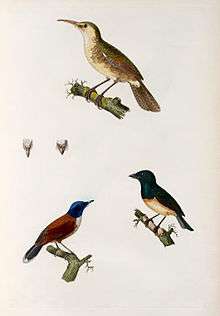Nightingale reed warbler
| Nightingale reed warbler | |
|---|---|
 | |
| Nightingale Reed-warbler | |
| Scientific classification | |
| Kingdom: | Animalia |
| Phylum: | Chordata |
| Class: | Aves |
| Order: | Passeriformes |
| Family: | Acrocephalidae |
| Genus: | Acrocephalus|Acrocephalus (bird)|Acrocephalus |
| Species: | A. luscinius |
| Binomial name | |
| Acrocephalus luscinius | |
| Synonyms | |
| |
The nightingale reed warbler (Acrocephalus luscinius), or Guam reed warbler, is an extinct song bird endemic to Guam. It has not been reported since the late 1960s and is now considered extinct.
Taxonomy and systematics
The nightingale reed warbler was originally described in 1830 by the French explorers and naturalists Quoy & Gaimard as Thryothorus luscinius. Until 2011, the Pagan reed warbler, Aguiguan reed warbler, and Saipan reed warbler were also considered as subspecies of the nightingale reed warbler until split by the IOC.[2]
Threats
The nightingale reed warbler was driven to extinction by several introduced species. These included the brown tree snake which has also decimated the populations of several other bird species on Guam. Other introduced predators included rats, cats and feral ungulates such as goats or sheep.[3] An introduced plant, ivy gourd, destroyed the canopy of the trees nightingale reed warblers built their nests in. Wetland destruction, fires and pesticides, as well as intensive land use for agriculture or building further reduced the available habitat.[4]
References
- ↑ BirdLife International (2013). "Acrocephalus luscinius". IUCN Red List of Threatened Species. Version 2013.2. International Union for Conservation of Nature. Retrieved 26 November 2013.
- ↑ "Species Version 2 « IOC World Bird List". www.worldbirdnames.org. Retrieved 2018-06-13.
- ↑ Rounds, Rachel; Radley, Paul. "Nightingale Reed-Warbler (Acrocephalus luscinia)". Web Page of Pacific Bird Conservation, Hawaii. Archived from the original on 21 September 2015. Retrieved 21 September 2015.
- ↑ "Acrocephalus luscinius". The IUCN Red List of Threatened Species. Version 2015-3. International Union for Conservation of Nature and Natural Resources. 2013. Archived from the original on 2013. Retrieved 22 September 2015.
